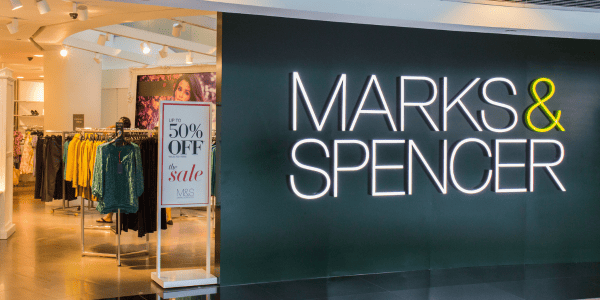When Marks met Spencer
Retail giant Marks & Spencer has been on the high street since the 19th century.
Starting out as a penny bazaar market stall, today the company has a net worth of more than £2.6 billion, with around 1,000 UK branches and a further 406 at locations all over the world, according to data published in September 2023.
Who founded Marks and Spencer?
The two founders, Michael Marks and Thomas Spencer, were bold entrepreneurs and astute businessmen, who set their fledgling venture on the road to success.
Over the years, the retailer has survived by adapting to change, while always retaining its core values of catering to the discerning customer who enjoys luxury and exclusivity.
With HQ based in Paddington, London, M&S promotes its products through clever advertising. In particular, its Christmas campaigns have proved legendary.
Who were Marks and Spencer?
The men behind the famous brand were individuals who each brought unique skills to the business relationship. Marks was a time-served salesman, while Spencer was an experienced accountant.
When they joined forces in 1894, their combined talents and business acumen led to the swift ascension of their company from a market stall to a prestigious business with bricks-and-mortar premises in major cities.
Apparently though, the company was very nearly called Marks & Dewhirst, as Spencer wasn’t Marks’ first choice as a business partner!
Michael Marks
Born in 1859 in Slonim, Belarus, Michael Marks was of Jewish heritage. In 1882, after fleeing Eastern Europe due to persecution from the Russians, the 23-year-old moved to Leeds, Yorkshire.
His first job was with clothing manufacturer John Barran and Sons, who employed Jewish refugees. Marks then found new work with Isaac Dewhirst, who owned a wholesale drapery warehouse in Leeds.
Marks thrived as a salesman, travelling round Yorkshire markets and villages selling Dewhirst’s products. He learned English very quickly to adapt to his new job. He then asked Dewhirst if he would go into partnership to grow the business further. Although he declined, Dewhirst loaned Marks £5 in 1884 to help found his own business.
Marks was ambitious and a hard worker. He soon saved enough money to rent his first penny bazaar stall at Leeds Kirkgate Market. Selling everything from wooden kitchen utensils to nails and screws, his advertising slogan was, “Don’t ask the price, it’s a penny.”
Thomas Spencer
Born in 1851 in Skipton, Yorkshire, Spencer moved to Leeds at the age of 20. He found work with Dewhirst as a bookkeeper, which gave him a solid grounding in accountancy.
As Marks was a travelling salesman, he and Spencer’s paths didn’t cross for some time. Their first meeting was in 1884 – ironically when Marks had asked Dewhirst to become his business partner.
Marks’ first stall in Leeds was already a huge success and he was in the process of opening more across Leeds and Wakefield. He was expanding the penny bazaar idea to the Pennines when he joined forces with Spencer.
Marks invested £300 in the new venture. He was responsible for running the stalls, while Spencer managed the financial side and supply chain.
Marks and Spencer history
Marks & Spencer had opened 36 penny bazaars across the UK by 1897, spanning from London and Birmingham to Sheffield, Bradford, Hull and Cardiff.
In 1903, the company became limited and built a new HQ in Manchester. Spencer retired later that year and sadly, he died in July 1905. Marks continued to be actively involved in the business and led its expansion until his death in December 1907.
During the 20th century, the brand became known for its high-quality wares. Its success continued, despite the death of both partners.
In 1909, the first M&S high street store opened in Briggate’s modern Cross Arcade in Leeds.
After surviving the austerities of World War I, in the post-war 1920s the products on sale reflected consumers’ changing lifestyle.
Demand for household goods grew. Practical products like batteries, irons and light bulbs were sold alongside decorative tea sets and crockery.
When World War II broke out in 1939, M&S had expanded to 234 stores. Sadly, by the end of the war in 1945, more than 100 had been bombed – 16 were totally destroyed.
London HQ opened in 1957 at Michael House at 55 Baker Street. The chain reached new heights of success during the latter part of the 20th century.
In 1999, M&S launched online shopping, which boosted its success going into the 21st century. They have also opened international outlets in places such as Dubai, Athens and Holland.
While shopping has changed significantly since the 19th century, the retail giant has maintained its success, surviving the world wars, recessions and economic challenges by adapting with the times, and never losing sight of its customer base and company ethos.
M&S has adopted an environmental policy to reflect the climate change emergency. It aims to become a net zero business by the financial year 2039/40 – a decade earlier than the government’s national strategy suggests.
Share this post
Tags
- Career Development
- Celebrity Meetings
- Conferences
- Confidence
- Exhibitions
- Historic Meetings
- How to Interview Effectively
- Human Resources
- In The Press
- Meetings and Conferences
- Monarchy
- News
- Our Team
- Personal Development
- Personnel
- Presentation Techniques
- Teamwork
- Top Tips for Meetings
- Training & Workshops
- Video Conferences




